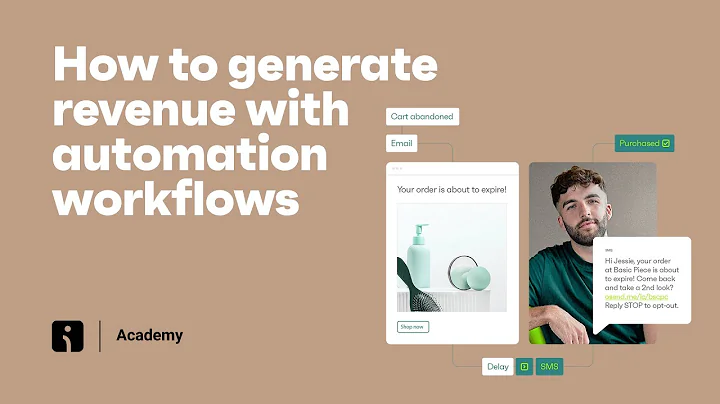Boost Conversion Rates: Master the Power of Copy and Design
Table of Contents
- Introduction
- Copywriting: The Power of Words
- 2.1 Understanding Your Audience
- 2.2 Creating Messaging Hierarchy
- 2.3 Highlighting Features and Benefits
- 2.4 Crafting Persuasive Stories
- Design: The Art of User Experience
- 3.1 Evaluating User Flow
- 3.2 Decreasing Friction
- 3.3 Minimizing Distractions
- 3.4 Ensuring Relevancy
- 3.5 Enhancing Clarity
- Testing and Improvement
- 4.1 Gathering Feedback from Others
- 4.2 Continuous Iteration for Optimization
The Power of Copywriting and Design in Conversion Rate Optimization
Introduction
Conversion rate optimization is a crucial aspect of online business success. By increasing the percentage of website visitors who make a purchase, businesses can improve their revenue and overall profitability. In this article, we will explore two proven ways to enhance your conversion rate: the art of copywriting and the science of design.
Copywriting: The Power of Words
Copywriting plays a significant role in persuading and engaging customers. It combines creativity with scientific techniques to create compelling content that drives conversions. Here are some tips to elevate your copywriting game:
2.1 Understanding Your Audience
To effectively communicate with your potential customers, you must first understand who they are and what motivates them. Conduct thorough research by sending surveys, reviewing comments on social media, or studying competitor's strategies to decipher your target audience's language and preferences.
2.2 Creating Messaging Hierarchy
People tend to scan rather than read entire descriptions. As a result, it is crucial to organize your messaging hierarchy from most to least important. Ensure that your key messages are easily visible and convey your points concisely. Highlight the primary features and benefits of your product or service to captivate your audience's attention.
2.3 Crafting Persuasive Stories
Telling a story can be a powerful way to communicate your brand message and entice customers to take action. Incorporate both factual information and vivid details, explaining how your product or service can be used. This storytelling approach helps establish an emotional connection and resonates with your audience.
Design: The Art of User Experience
The design of your website has a profound impact on how users interact with your store and whether they make a purchase. By focusing on simplicity, usability, and friendliness in your design, you can enhance the user experience and boost conversions. Consider the following steps to evaluate and improve your website's design:
3.1 Evaluating User Flow
Place yourself in the shoes of a potential customer and evaluate their journey on your website. Are you effectively guiding them towards taking action? Ensure that your top-selling products are easily accessible within two clicks from the home page. Remove any unnecessary steps or confusion that may hinder the conversion process.
3.2 Decreasing Friction
Identify any elements on your website that may cause confusion, difficulty, or roadblocks for your customers. Streamline the user experience by minimizing friction points and making navigation intuitive. Simplify your menu by including only essential items that visitors are familiar with, such as "shop" and "about us."
3.3 Minimizing Distractions
To maintain customer engagement, it is crucial to reduce any distractions that might divert their attention from making a purchase. Avoid cluttered home page menus and focus on providing relevant and concise information. By eliminating unnecessary options and visual noise, you can guide users towards the desired action.
3.4 Ensuring Relevancy
Outdated or irrelevant content can erode trust in your brand. Regularly review your website for any obsolete information, blogs, or customer reviews. Keeping your content up to date demonstrates credibility and instills confidence in potential customers.
3.5 Enhancing Clarity
Complexity and confusion can be major deterrents to conversions. While offering choice is important, having too many options can overwhelm customers and lead to decision paralysis. Strive for clarity in your website design by presenting information, products, and pricing in a clear and straightforward manner. This allows customers to make confident purchasing decisions.
Testing and Improvement
Continuous testing and improvement are essential for optimizing conversion rates over time. Seek feedback from others, such as friends or family members, who can provide fresh perspectives on your website's flow, messaging, and design. Iterate based on their suggestions and monitor the impact on your conversion rates.
4.1 Gathering Feedback from Others
Involving others in the review process can uncover blind spots and areas for improvement. Ask for honest feedback from individuals who represent your target audience or have knowledge and experience in website design. Their insights can help you identify weak points and refine your conversion strategy.
4.2 Continuous Iteration for Optimization
Remember that conversion rate optimization is an ongoing process. Websites are constantly evolving, and there is always room for improvement. Continuously monitor your conversion rates, analyze user behavior, and make iterative changes to ensure optimized performance.
By mastering the art of copywriting and the science of design, you can significantly increase your conversion rate. Adapting your messaging to resonate with your audience and optimizing your website's design for seamless user experience will pave the way for improved conversions and business growth.
Highlights:
- Understand your audience to spark the right emotions for persuasion.
- Prioritize messaging hierarchy and concise communication.
- Craft persuasive stories to establish an emotional connection.
- Ensure a simple, usable, and friendly design for enhanced user experience.
- Evaluate user flow and minimize friction to facilitate conversions.
- Remove distractions and irrelevant content to build trust.
- Strive for clarity and provide a focused range of choices.
- Gather feedback from others for a fresh perspective.
- Continuously iterate and optimize for improved conversion rates.
FAQ:
-
How can copywriting improve conversion rates?
- Copywriting allows businesses to effectively communicate with their audience, persuading them to take action. By understanding your audience, creating a messaging hierarchy, highlighting features, and crafting persuasive stories, you can influence customers' purchasing decisions.
-
Why is design important in conversion rate optimization?
- The design of a website plays a crucial role in guiding users and enhancing their experience. By evaluating user flow, decreasing friction, minimizing distractions, ensuring relevancy, and enhancing clarity, businesses can create a user-friendly environment that encourages conversions.
-
How can I gather feedback to improve my website?
- Seek feedback from others, such as friends, family, or individuals representing your target audience. Ask for their honest opinions on your website's flow, messaging, and design. Incorporate their suggestions and continuously iterate to optimize your conversion rates.






















